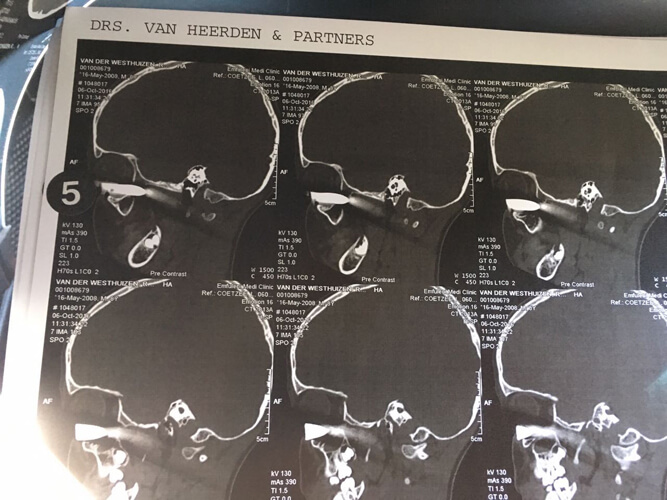It was just an average Thursday and eight-year-old Ryno van der Westhuizen was happily playing at home. However, what happened next can only be described as a freak accident.
A door handle pierced Ryno’s lower eye socket when he had a fall whilst playing. The impact of his fall caused the handle to break off and Ryno was left with a five-centimetre piece of metal lodged right below his left eye.
He was rushed to a nearby hospital for urgent treatment. “The fact that he survived unscathed and that the piece of metal caused no damage to his eye or brain is a miracle and it is only because of God’s amazing power that he survived,” says Ryno’s mother, Jonet van der Westhuizen. “A CT [computerized tomography] scan called for by the doctors showed that the piece of metal had missed his brain by millimetres and had miraculously not caused any damage to nerves of his eye either.”
Even though Ryno was safe for the time being, the real challenge facing the doctors was to safely remove this dangerous metal object. The longer it remained wedged into his lower eye socket, the higher Ryno’s risk of infection and further harm would have been.
“It stood to reason that urgent action was required and he was therefore transported via ambulance to Netcare Clinton Hospital for highly specialised surgery. When he was admitted to the paediatric ICU, Dr Wiebo van der Meulen, a consultant neurosurgeon at Netcare Clinton Hospital, was already waiting for him,” explains Van der Westhuizen.
Dr Van der Meulen was shocked and amazed by Ryno’s injury. “I literally could not believe it; in cases like Ryno’s, where there is a deep penetration in the eye cavity, it is extremely unusual for no permanent damage to occur,” said Dr Van der Meulen. “You would expect catastrophic damage to the eye or the brain, but miraculously, scans showed no permanent damage to either. He is a very lucky young boy.”
After a comprehensive assessment, Dr Van der Meulen and the other doctors involved in his treatment concurred that the object had to be removed. Ryno was transported by ambulance to Netcare Union Hospital, across the road, where the procedure was to be undertaken in the catheterisation laboratory.
“The diagnostic imaging equipment in the catheterisation laboratory is operated by a highly specialised team and is generally used to visualise the arteries and the chambers of the heart, in order to make a diagnosis and treat intricate cardiovascular conditions with minimally invasive procedures,” explains Dr Van der Meulen.
“If we had to take out the piece of metal from his eye without the aid of this type of equipment, there would have been a high risk of profuse bleeding, which could have caused irreparable damage. The cutting edge equipment allowed us to perform an angiogram, not dissimilar to an X-ray, but instead focused on the blood and lymph vessels using a coloured die to plot the safest route for the removal of the object.

The door handle that was lodged in Rynos’ eye. It was about five centimetres long.

The CT scans showing the location of the door handle in Ryno’s eye socket.
As we were able to see the relation of the object to the blood vessels in the eye cavity, it assisted us greatly in removing it safely without causing further damage,” explained Dr Van der Meulen.
“We rarely use the catheterisation laboratory for maxillofacial surgery, ophthalmology or neurosurgery,” he added. “Ryno’s case, however, was so unusual and so much was at risk that we had to find an unusual and the safest possible approach. The catheterisation laboratory provided the ideal solution,” he said.
Ryno underwent the surgical procedure on 8 October. “I think it’s every mother’s worst nightmare to let her child disappear through the swing doors of a hospital theatre, but I fully trusted the incredible team of doctors at Netcare Union and Netcare Clinton hospitals,” said Jonet.
The surgery took just over an hour and involved a total of four specialists including an anaesthetist, a radiologist specialising in neuro intervention, an eye specialist and of course, Dr Van der Meulen. Thankfully, everything went as planned and the object was removed from Ryno’s eye without resulting in any internal bleeding. Furthermore, there was no damage whatsoever to the nerves of Ryno’s eye or to his brain.
“He has since made a full recovery and is able to see clearly out of both eyes,” said Dr Van der Meulen. “It really is astonishing, almost inexplicable, and we couldn’t have asked for a better outcome and a happier ending given the nature of his unusual injury.”
Ryno’s parents were overjoyed by his recovery. “Thank you to Dr Van der Meulen and his phenomenal team, Dr Hennessey, Dr Dos Ramos, Dr Ismail, Prof Mngomezulu and Shaun Steyn. We are so thankful to God for bringing these incredible doctors together at the right time. God has used them as instruments to save my boy. May God bless their hands,” conveyed the thankful mother.
“Ryno is back to school and has not had any problems with his eyes since his intricate procedure. The medical team gave him a second chance at life and that is the best gift any boy could possibly ask for,” Jonet concluded.
Ends
Issued by: Martina Nicholson Associates (MNA) on behalf of Netcare Clinton and Netcare Union hospitals
Contact: Martina Nicholson, Graeme Swinney, Meggan Saville or Pieter Rossouw
Telephone: (011) 469 3016
Email: [email protected], [email protected], [email protected] or [email protected]